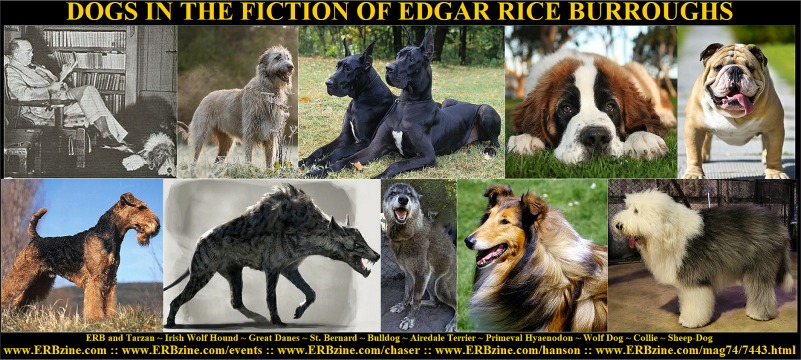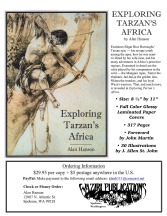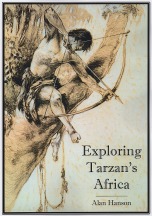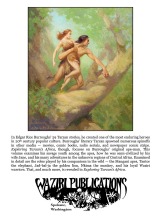
Dogs in the Life and Fiction
of ERB
Part 3: Canine Imagery
by Alan Hanson
The two kinds of animals that Edgar Rice Burroughs owned
and loved best were horses and dogs. It’s not surprising, then, that he
often used his knowledge of and affection for those two domestic species
in his fiction. Leaving ERB’s horses for another time, let’s conclude our
survey of domestic dog references in his fiction. Following are examples
of the many non-specific dog images to be found in the author’s stories.
“You’ve-Seen-It” Images
As Burroughs often used his real life experience with
dogs often to create images in his fiction, he at times asked his readers
to do the same. Following are some examples of his inviting the reader
to recall their experiences with their own dogs to help visualize images
in his stories.
“It is the running creature that attracts the beast
of prey. You have seen that exemplified by your own dog, which is a descendant
of beasts of prey. Whatever runs he must chase.” (Tarzan and
the Lion Man)
“The threatening bull (Akut) continued his stiff and
jerky circling of the ape-man, much after the manner that you have noted
among dogs when a strange canine comes among them.” (The Beasts
of Tarzan)
“You have seen it demonstrated a thousand times — a
dog recognizes your voice and looks at you. He knows your face and figure.
There can be no doubt in his mind that it is you; but is he satisfied?
No, sir — he must come up and smell you. All his other senses may be fallible;
but not his sense of smell, and so he makes assurance positive by the final
test.” (Tarzan the Untamed)
“The eyes of the princess seldom leave thee whilst
thou art at practice upon the lists and they look in thine when they rest
upon her — hast ever seen a hound adoring his master?” (Tarzan,
Lord of the Jungle)
“Then I sat stroking the savage head and talking to
the beast in the man-dog talk with which you are familiar, if you ever
owned and loved a dog.” (Pellucidar)
“You have seen a dog, perhaps your own dog, half recognize
you by sight; but was he ever entirely satisfied until the evidence of
his eyes had been tested and approved by his sensitive nostrils? And so
it was with Nkima.” (Tarzan the Invincible)
“Jad-bal-ja, the golden lion, had conceived a strange
affection for La of Opar … He seemed to find the same pleasure in her company
that a faithful dog finds in the company of his master.” (Tarzan
the Invincible)
“[Janai] never touched me, if she could avoid it; nor
did she often look directly at my face, nor could I blame her; yet I was
sure that she was becoming fond of me as one becomes fond of an ugly but
faithful dog.” (Synthetic Men of Mars)
Indirect Comparisons
Burroughs also often used indirect comparisons to
create images in his fiction. Many times he used the actions of dogs to
help the reader visualize the actions of his human characters. Some examples:
“Ordinarily Tarzan of the Apes was asleep as quickly
as a dog after it curls itself upon a hearth rug before a roaring blaze.”
(Jungle Tales of Tarzan)
“Lajo was standing erect in the bow apparently sniffing
the air, as might a hunting dog searching out a scent spoor.” (Tarzan
at the Earth’s Core)
“It is said that a sleeping dog awakened by the touch
of a cart wheel reacts so quickly that he can escape harm by leaping aside
before the wheel crushes him. I do not believe this; but I am convinced
that the so-called lower animals awaken in full and complete possession
of all their faculties; not slowly, faculty by faculty, as in the case
with man. Thus awoke Tarzan, master of all his powers.” (Tarzan
and the City of Gold)
“‘Stick to your hunting, Thak Chan,’ warned Chal Yip
Xiu, ‘or you will end upon the sacrificial block or in the waters of the
sacred well. Get you gone.’ Thak Chan went; he sneaked out like a dog with
its tail between its legs.” (The Quest of Tarzan)
“Tarzan was murdering her husband — choking the life
from him — shaking him as a terrier might shake a mouse.” (The
Return of Tarzan)
“Professor Porter rolled over upon his stomach; gingerly
he bowed his back until he resembled a huge tom cat in proximity to a yelping
dog.” (Tarzan of the Apes)
“‘Wait,’ his companion cautioned him, and went and
whispered in his ear, whereupon [the Zani Guards] both turned and left
the lobby like a couple of whipped dogs.” (Carson of Venus)
“[Gunto] sidled off, quite stiff and haughty, after the
manner of a dog which meets another and is too proud to fight and too fearful
to turn his back and run.” (Jungle Tales of Tarzan)
“The black servants and the Waziri warriors … presented
to Nu’s nostrils an unfamiliar scent — one which made the black shock upon
his head stiffen as you have seen the hair upon the neck of a white man’s
hound stiffen when for the first time his nose detects the odor of an Indian.”
(The Eternal Lover)
(When he served in the 7th Cavalry in Arizona, Burroughs
may have seen a “white man’s hound” react as described to the “odor
of an Indian.” Personally, I’ve known many Native Americans, but I’ve
never noticed a distinctive “odor” in their presence.)
Dog Insults
It was time for William Clayton to pay up for losing
a game of life and death. In a lifeboat adrift for days at sea, Clayton,
Jane Porter, and Nicholas Rokoff were near death. His drawn the fatal coin
meant that Clayton’s body was to provide the sustenance needed for the
others to survive. The two men lay at opposite ends of the lifeboat, however,
and Rokoff lacked the strength to collect his winnings. “I cannot crawl,”
he wailed. “It is too late. You have tricked me, you dirty English dog.”
Apparently, during the years of Edgar Rice Burroughs’
career, calling another person a “dog” was a commonly used smear.
The author used that and other canine-based insults across the wide range
of his fiction, even reaching as far out as Mars and Venus. In his early
settings, the author was using “dog” insults even before he wrote
The
Return of Tarzan, in which the above scene appears.
In the opening pages of just his second novel, The
Outlaw of Torn, set in the 13th century, English King Henry III
called De Vac, his master of fence, “Dog!” as he struck him a blow
across the face and spit on him. Knowing he would die if he struck back,
De Vac endured the insult. A Frenchman by birth, he thought the English
king was “a dog; and who would die for a dog?” Instead, he conspired
to make the “Plantagenet dog taste the fruits of his own tyranny.”
While De Vac quietly plotted revenge against Henry, the king raged over
the crimes of the Outlaw of Torn. “Let your men take the dog,” he ordered,
declaring, “hang the dog.”
In contemporary times, the ERB characters who hurled the
“dog” insult most often were Arabs. Some examples: In The
Lad and the Lion, an Arab thought the “Lad” (Aziz) “was
doubtless a Nasrâny — dog of an unbeliever.” And in Tarzan,
Lord of the Jungle, the Arab chief, Ibn Jad plotted to have the
American Stimbol kill Tarzan. “Thus we shall be rid of two unbelieving
dogs,” he hoped. Then, in Tarzan the Invincible, Sheikh
Raghunath Jafar referred to Russian Peter Zveri as a “dog of a Nasrâny.”
Finally, in The Quest of Tarzan, when the villainous Abdullah
heard the caged Tarzan talk to a fellow captive, the surprised Arab declared,
“The dog of an Engleys speaks!” There are many other examples to
be found in Burroughs’ fiction of Arabs besmirching Christians with canine
insults.
Though not as often in ERB’s fiction, Europeans at times
returned the insult in kind to Arabs. In The Son of Tarzan,
French Captain Armand Jacot faced off with Sheik Amor ben Khatour. “Take
this black dog back to his people,” the Frenchman ordered. In Tarzan
the Invincible, Peter Zveri returned Raghunath Jafar’s insult when
he told one of his men, “Don’t mention that dog to me.” And in The
Quest of Tarzan, the scoundrel Krause was referring to the Arab,
Abdullah, when he said, “We sail in three days, whether that Arab dog
is back or not.”
Earlier, a reference was made to a Burroughs narrative
statement in The Eternal Lover that the neck of a white man’s
hound would “stiffen when for the first time his nose detects the odor
of an Indian.” In Apache Devil, ERB showed an Indian could be equally
disparaging of white men. “This firewater of the white-eyed men is poison,”
declared Shoz-Dijiji. “To drink it is the madness of a fool, but even worse
is the drinking of it in friendship with the white-eyed dogs.”
Tarzan was also labeled a “dog” at least a half
dozen times. In The Return of Tarzan, an Arab trying to pick
a fight with Tarzan, said, “Besides being a dog yourself, you are the
son of one, and your grandmother is a hyena.” An Arab attack on the
ape-man was then initiated by cries of “Kill the unbeliever!” and
“Down with the dog of a Christian!” Later in the same story, the
villain Nicholas Rokoff yelled, “Get up, you dog!” before kicking
the bound Tarzan in the side. In The Quest of Tarzan, Abdullah
Abu Néjm said of the caged Tarzan, “He is less than a dog,”
and later adding, “The dog has not eaten for two days … In the jungle
he eats raw meat from his kills, like a beast.” In Tarzan and
the Lost Empire, the emperor Sublatus didn’t appreciate Tarzan’s
attitude when the ape-man was brought before him. “Take the insolent
dog away,” he ordered with a trembling voice. Once Tarzan even compared
himself to a dog. Referring to Queen Nemone in Tarzan and the City
of Gold, the ape-man asked his friend Gemnon, “What does she
want of me? Am I to remain in this house, caged up like a pet dog, to run
at the beck of a woman?”
Moving off planet, dog insults were commonly flung by
and at Burroughs’ Martian characters. Since the primary canine species
on Barsoom was the “calot,” that term was used there as an insult
in the same way “dog” was used on Earth. However, on a couple of
occasions in The Gods of Mars, Barsoomians used the earthly
term to insult John Carter. The first was a woman whose declaration of
love was rejected by Carter. “Dog of a blasphemer! Think you that Phaidor,
daughter of Matai Shang, supplicates? She commands.” The second was
also a woman, one of the Black Pirate race, who was trying to start a fight.
“Thurid is a noble Dator,” she said. “Let Thurid show the dog
(Carter) what it means to face a real man.”
The dog insult was also used on Burroughs’ Venus world
of Amtor. When Carson Napier tried to enlist in the Zani military without
the proper paperwork, the recruiter responded, “What! No credentials,
you mistal? You are probably a dog of a spy from Sanara.”
For the sake of melodrama, Burroughs occasionally had
his characters use other canine identifiers as insults. For instance, when
the villainous Maenck voiced his intention to “examine the king’s mistress”
in The Mad King, Barney Custer responded, “You cur! You’re
going to eat that, word for word.” When Orthis led his Lunar army in
an invasion of Earth, he faced off with Julian 5th. “You damned cur,”
the invader cried. “All my life you have stolen everything from me.”
And in The Efficiency Expert, Elizabeth Compton called Jimmy
Torrance a “despicable cur” when he threatened to expose her indiscreet
social activity to her father.
Burroughs used one other related dog insult. Barney Custer
addressed one to King Leopold when the monarch called him an “ingrate.”
Barney replied, “You have the effrontery to call me an ingrate? You
miserable puppy.” In The Man-eater, Judge Sperry used
the same insult when announcing his personal punishment for the fraudster
Scott Taylor. “I intend to kick this miserable little puppy into the
road,” he declared. Then, in Tarzan’s Quest, the snobbish
Alexis Sborov called his hired servant an “impertinent puppy.”
Dog Owners
Among the most prominent dog owners in Burroughs’
fiction were John Carter (Woola), David Innes (Raja and Ranee), Bowen Tyler
(Nobs), and O-aa (Rahna). ERB’s paramount dog owner, however, was Tarzan.
He not only owned two of the nine dogs named by the author — Terkoz and
Za — but his African estate was also home to at least a dozen other dogs.
In The Son of Tarzan, the author mentions “gaunt wolf
hounds, a huge great Dane, a nimble-footed collie and a number of yapping,
quarrelsome fox terriers” gathered around the Greystoke bungalow. Years
later, Tarzan’s dogs made a cameo appearance in Tarzan and the Ant
Men. When everyone at Tarzan’s African home thought the badly injured
Esteban Miranda was Tarzan, only the ape-man’s dogs knew he was an imposter.
“The dogs that had once loved Lord Greystoke slunk from this brainless
creature.”
Although Tarzan obviously loved his dogs, he did not hesitate
to kill someone else’s dog when necessary. One ill-fated canine crossed
the ape-man’s path in Tarzan the Untamed. Unfortunately for
that dog, he interfered with Tarzan’s search for the German soldiers whom
he believed had killed his wife.
“[Tarzan] moved stealthily from building to building
until at last he was discovered by a large dog in the rear of one of the
bungalows. The brute came slowly toward him, growling Tarzan stood motionless
beside a tree. He could see a light in the bungalow and uniformed men moving
about and he hoped that the dog would not bark. He did not; but he growled
more savagely and, just at the moment that the rear door of the bungalow
opened and a man stepped out, the animal charged.
“He was a large dog, as large as Dango, the hyena,
and he charged with all the vicious impetuosity of Numa, the lion. As he
came Tarzan knelt and the dog shot through the air for his throat; but
he was dealing with no man now and he found his quickness more than matched
by the quickness of the Tarmangani. His teeth never reached the soft flesh
— strong fingers, fingers of steel, seized his neck. He voiced a single
startled yelp and clawed at the naked breast before him with his talons;
but he was powerless. The mighty fingers closed upon his throat; the man
rose, snapped the clawing body once, and cast it aside. At the same time
a voice from the open bungalow door called: ‘Simba!’”
Another owner of multiple dogs appeared in Burroughs’
Western novel, The Deputy Sheriff of Comanche County. Early
in the story, a group of dude ranch guests saddled up for a backcountry
adventure.
“For three days the party rode deeper into a wilderness
of mountains and meadows until they reached their destination, a tiny shack
beside a leaping trout stream in a valley hemmed by lofty mountains, where
lived Hi Bryam, the owner of four good lion dogs that the party was to
use in the forthcoming hunt.”
Later, Bryam conspired with the scoundrel Corey Blaine
and others to kidnap the story’s lovely heroine, Kay White. The damsel
was first held at Bryam’s shack, with the gang later deciding to move her
to a more remote hideout. “What are you goin’ to do with the pooches, Hi?”
asked one of his fellow abductors. “Leave ’em here,” Bryan responded.
“They can rustle plenty grub in the hills,” he explained. “Won’t
they follow us?” asked another gang member. “Not if I tell ’em to
stay here,” Bryam replied.
Arizona Deputy Sheriff Buck Mason (aka Bruce Marvel) later
tracked the kidnappers to Bryam’s shack.
“As Marvel drew up before the shack he called aloud
to attract attention. The dogs had already come to meet him, but outside
of this there were no signs of life about the place … He dismounted; and
as the dogs came to nose him, he petted the nearer of them, but all the
while his eyes were on the ground; and from the trees on the hillside Bryam
watched him.”
Bryam fired first, but he was the one left soaking up
the dirt on the ground near his shack. When a lawman arrived later, the
first thing he saw was Bryam’s four dogs bristling and growling in defense
of their master as his life ebbed away. When the deputy dismounted, “the
hounds withdrew a short distance watching him suspiciously.” The deputy
moved on, following Marvel’s trail. Bryam finally died where he had fallen,
but his dogs remained loyal to him still. “Above, on ragged wings, great
black birds swung in easy, majestic circles. Occasionally one of them would
swoop lower; but four bristling, growling hounds kept them at bay.”
In the Tarzan stories, African native villages were home
to large numbers of dogs. Burroughs’ descriptions of native villages almost
always contain references to dogs. Below are just a few of those depictions.
“A single stroke of Doc’s knife severed the rope and
the chain clattered to the ground — an occurrence that almost proved their
undoing for the noise startled a nearby cur into a frenzy of barking that
was quickly taken up by every other dog in the village, until it seemed
that a thousand dogs were yapping at the top of their lungs.” (The
Tarzan Twins)
“A score of native curs attracted by the yelping of
their mate and the yells and shouts of their masters had closed in upon
the fleeing white man (Korak), snapping at his legs and at last succeeding
in tripping him. As he went down the hyena-like brutes were upon him, and
as he struggled to his feet the blacks closed in … Weighed down as he was
by dogs and warriors he still managed to struggle to his feet.” (The
Son of Tarzan)
“As they palavered the ape-man’s keen eyes took in every
detail of the village and its people, and presently they alighted upon
a large bitch among the numerous curs that overran the huts and the street.”
(Tarzan and the Golden Lion)
“Among the close massed fighters, excited curs ran
yelping and barking … Slowly Tarzan was gaining ground toward one of the
coveted walls of the village where, as he stepped quickly backward to avoid
a blow, he stumbled over a yapping cur and went down beneath a dozen men.”
(Tarzan Triumphant)
Breeds of Dogs
In his stories, Edgar Rice Burroughs included references
to various breeds of dogs. In The Gods of Mars, he noted
that the plant men in the Valley Dor “sprang with the agility of greyhounds,”
and in Tarzan the Untamed, the ape-man so thoroughly tamed
a lion, “that he was presently pacing along at the ape-man’s side like
some huge St. Bernard.” In The Return of Tarzan, the
ape-man’s fingers clung to the throat of an enemy “with the grim tenacity
of a bulldog.” Burroughs described a Martian rat (an ulsio) in The
Chessmen of Mars as being “in size and weight comparable to
a large Airedale terrier.”
Canine History
In his fiction, Burroughs commented on the history
of domestic dogs. In Pellucidar, the author had David Innes
speculate on how dogs first were tamed.
“Perry argues that wild dogs were first domesticated
for hunting purposes; but I do not agree with him. I believe that if their
domestication were not purely the result of an accident, as, for example,
my taming of the hyaenodon (Raja), it came about through the desire of
tribes who had previously domesticated flocks and herds to have some strong,
ferocious beast to guard their roaming property. However, I lean rather
more strongly to the theory of accident.”
Burroughs made the domestication of dogs a theme in his
trilogy, The Moon Maid. In part two, The Moon Men,
Burroughs created a new and terrible breed of dog as part of his gloomy
vision of life in the environs of Chicago in the early twenty-second century.
Julian 9th described this new, wild canine strain that the collapse of
American society had allowed to arise through the uncontrolled cross-breeding
of once domesticated dogs.
“After supper father and I went out and milked the
goats and saw that the sheds were secured for the night against the dogs.
It seemed as though they became more numerous and more bold each year.
They ran in packs where there were only individuals when I was a little
boy and it was scarce safe for a grown man to travel an unfrequented locality
at night. We were not permitted to have firearms in our possession, nor
even bows and arrows, so we could not exterminate them and they seemed
to realize our weakness, coming close in among the houses and pens at night.
“They were large brutes — fearless and powerful. There
was one pack more formidable than the others which father said appeared
to carry a strong strain of collie and Airedale blood — the members of
this pack were large, cunning and ferocious and were becoming a terror
to the city — we called them Hellhounds.”
However, over 300 years later, in part three of the trilogy,
the Americans had reestablished their society and culture in a pattern
similar to that of the Plains Indians of centuries past and had driven
the Kalkar invaders to the far western edge of the continent. They would
not have been able to do so, though, without first re-domesticating some
fierce breeds of dogs. Together, the 50 American clans had two thousand
“shaggy hounds” trained to protect the Americans’ great herds from
attack by coyotes, wolves, and hellhounds. “If the brutes knew their
own strength, they could, I believe, exterminate us,” noted Julian 20th
of the wild dogs, “for their numbers are appalling; but they hold us in
great fear because we have waged relentless warfare against them for hundreds
of years.” Working in groups of 50, their trained hounds guarded the
herds that accompanied the clans when they were on the move. The Americans
could never have pushed the Kalkars across the continent without the help
of their dog packs.
In The Moon Maid, Burroughs showed how essential
domesticated dogs are for the existence of society as a whole. However,
the importance of one dog to one man was just as important. David Innes
learned that lesson in Pellucidar after he tamed the wolf
dog that he named Raja.
“And so we walked on together toward Thuria — I talking
to the beast at my side, and he seeming to enjoy my company no less than
I enjoyed his. If you don’t think it’s lonesome wandering all by yourself
through savage, unknown Pellucidar, why, just try it, and you will not
wonder that I was glad of the company of this first dog — the living replica
of the fierce and now extinct hyaenodon of the outer crust that hunted
in savage packs the great elk across the snows of southern France, in the
days when the mastodon roamed at will over the broad continent of which
the British Isles were then a part, and perchance left his footprints and
his bones in the sands of Atlantis as well.”
—the end—



![]()
 .
. .
.
![]()
![]()
![]()
![]()
![]()
![]()

![]()